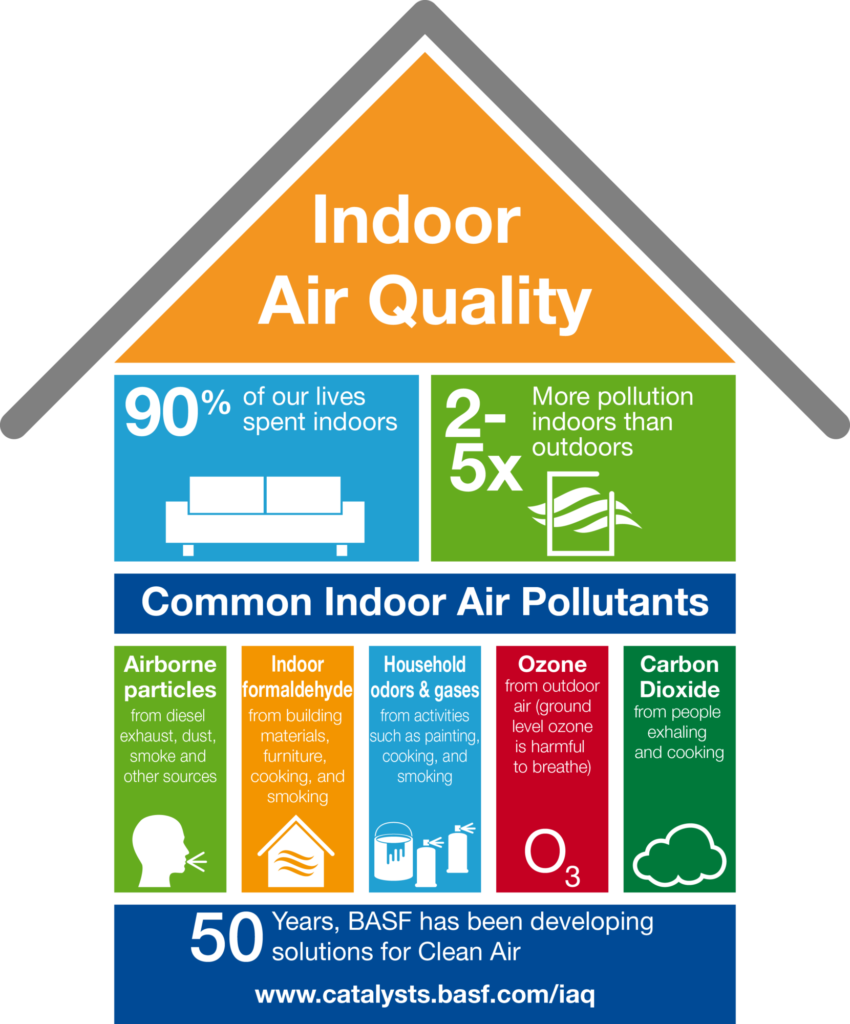Indoor air quality is a crucial factor that significantly impacts our overall health and well-being. As we spend up to 90% of our lives indoors, the quality of the air we breathe in our homes, offices, and schools is essential for promoting a healthy living environment. Poor indoor air quality, often resulting from dust and air pollutants, can lead to various indoor health effects, including reduced productivity and cognitive function. Understanding the air quality impact in our spaces can facilitate a commitment to workplace wellness and healthier buildings. By adopting strategies to improve air quality, we can foster environments that support our physical and mental health.
The atmosphere within our enclosed spaces, often referred to as indoor environmental quality, plays a pivotal role in shaping our daily lives. This concept encompasses factors such as ventilation, temperature, lighting, and importantly, the cleanliness of the air we inhale. With a significant portion of our time spent in these indoor environments, it’s vital to address sources of pollutants and allergens that can deteriorate our well-being. Awareness of how indoor settings affect health can lead to the enhancement of our living and working conditions, ensuring that we thrive free from the adverse effects of poor air quality. Taking proactive measures to create healthier indoor spaces not only uplifts our quality of life but also promotes a sustainable future.
The Importance of Indoor Air Quality for Health
Indoor air quality (IAQ) plays a critical role in our overall health and well-being, especially considering that Americans spend about 90% of their lives indoors. Poor air quality can result from a variety of pollutants including dust, allergens, and chemicals that accumulate in our buildings, resulting in negative indoor health effects. For instance, inadequate ventilation and high levels of humidity can exacerbate respiratory issues, trigger allergies, and even contribute to chronic health conditions. A well-ventilated building promotes healthy buildings by allowing fresh air to circulate, helping to dilute airborne contaminants.
Studies indicate that improving IAQ can have significant positive impacts on workplace wellness and cognitive function. Research from Harvard showed that increased air ventilation in offices not only improved cognitive performance but also enhanced overall workers’ satisfaction. With the growing awareness around indoor air quality, more organizations are investing in better air filtration systems and other technologies to mitigate the impact of dust and air pollutants. This shift not only boosts employee productivity but also enhances the quality of life in workplaces.
Understanding Indoor Health Effects and Their Solutions
Indoor health effects can be attributed to numerous factors, including inadequate ventilation, the presence of mold, and exposure to toxic materials. These conditions may lead to symptoms like fatigue, headaches, and difficulty concentrating, commonly referred to as ‘sick building syndrome.’ Recognizing the sources of indoor pollutants is essential in creating a healthier living and working environment. For example, many everyday products, such as cleaning supplies and paints, release volatile organic compounds (VOCs) that can deteriorate the air quality within buildings.
To combat these indoor health effects, awareness and proactive measures are essential. Maintaining optimal air quality involves implementing routine cleaning practices to minimize dust accumulation and using high-efficiency particulate air (HEPA) filters in heating and cooling systems. Additionally, increasing the amount of outdoor air that enters buildings can significantly reduce the concentration of indoor air pollutants, promoting a healthier lifestyle. Employers and building managers should prioritize investments in air quality improvements to safeguard health and increase productivity.
The Impact of Building Design on Air Quality
Building design significantly influences indoor air quality and can either mitigate or exacerbate health effects. For instance, poorly designed indoor spaces with limited airflow and insufficient ventilation systems trap pollutants and dust, making it difficult for occupants to breathe clean air. Modern building practices are now focusing on creating environments that prioritize natural ventilation and utilize materials that do not emit harmful substances. This shift towards healthier buildings not only benefits the individuals inside but also contributes to a broader goal of sustainability.
Moreover, integrating green spaces and natural lighting into building designs can enhance the overall indoor environment, providing psychological benefits that accompany improved air quality. Evidence suggests that exposure to nature within indoor spaces can reduce stress and inspire creativity. Therefore, architects and builders play an essential role in shaping healthy buildings that positively affect indoor air quality, contributing to better health outcomes for inhabitants.
Workplace Wellness and Air Quality Improvement
Workplace wellness has become a central focus for businesses aware of the connection between air quality and employee performance. Improving indoor air quality within office settings is crucial, as it directly affects workers’ cognitive functions and overall satisfaction. Studies indicate that employees are more productive in environments with good air circulation and minimal pollutants. Companies that implement air purification systems and invest in regular air quality assessments demonstrate a commitment to their employees’ well-being, boosting morale and retention.
Moreover, educational programs can inform employees about the significance of maintaining good air quality. Simple practices, such as reducing clutter that collects dust and using low-VOC products, can collectively enhance the office environment. By prioritizing air quality, organizations not only fulfill their duty of care to employees but also create a vibrant workplace that fosters collaboration and innovation.
Dust and Air Pollutants: Hidden Dangers in Indoor Spaces
Dust is more than just a nuisance; it can contain various pollutants that impact indoor air quality and health. Dust particles can harbor allergens like pet dander, pollen, and mold spores, which can aggravate respiratory issues and lead to chronic health problems. Regular cleaning and maintenance are essential to minimize dust accumulation in work and home environments. Ignoring this aspect of health could result in increased sick days and reduced quality of life for occupants.
In addition to allergens, dust can also contain harmful substances such as lead, asbestos fibers, and chemical residues. Implementing strict cleaning protocols that emphasize high-frequency vacuuming with HEPA filters and using microfiber cloths can significantly reduce the amount of dust and associated air pollutants in indoor environments. Awareness and effective cleaning strategies can ensure that buildings remain healthy and conducive to well-being.
Creating Healthy Buildings for Better Living
Creating healthy buildings requires a concerted effort to design spaces that prioritize indoor air quality and occupant well-being. This entails considering ventilation, material selection, and the incorporation of natural elements in design. Healthy buildings not only enhance physical health but also improve mental health by creating environments that inspire and energize inhabitants. Implementing these principles can reduce costs related to healthcare and absenteeism while promoting productivity.
Furthermore, collaboration among architects, builders, and health professionals is crucial for developing guidelines that promote healthy building designs. Regulatory bodies can support these initiatives by providing frameworks that outline best practices for air quality management and pollutant control. Investing in healthy buildings represents a commitment to health, sustainability, and a brighter future for communities and organizations.
The Role of Technology in Enhancing Indoor Air Quality
Advancements in technology have provided innovative solutions for improving indoor air quality, which can significantly mitigate indoor health effects. For example, smart ventilation systems can automatically adjust airflow based on occupancy levels and air quality measurements, ensuring optimal conditions for inhabitants. Additionally, air quality monitors can help track pollutants and humidity levels, allowing building managers to address issues proactively before they escalate.
Integrating air purification technology with existing HVAC systems can further enhance air quality and reduce indoor air pollutants. Devices equipped with UV-C light or advanced filtration systems can eliminate airborne pathogens and allergens, creating healthier environments for occupants. As technology continues to evolve, so will the methodologies for maintaining safe and healthy indoor spaces, ensuring that residents and workers thrive.
Strategies for Improving Indoor Air Quality in Schools
Schools are vital environments where children spend a significant amount of their time, making indoor air quality especially crucial. Poor air conditions can negatively impact students’ concentration, learning abilities, and overall health. Implementing strategies such as increased ventilation, regular cleaning schedules, and air quality monitoring can significantly improve indoor environments in schools. Active engagement from the school community can help lobby for necessary changes and prioritization of health and wellness initiatives.
In addition to infrastructure improvements, educating students and staff about the sources and effects of indoor air pollutants can empower them to take actionable steps towards a healthier environment. Awareness campaigns, alongside hands-on activities that promote good practices, can foster a culture of health and wellness. Schools that prioritize air quality not only enhance students’ academic performance but also create a nurturing environment that promotes overall well-being.
The Future of Indoor Environments: Trends Toward Healthier Spaces
As awareness about the significance of indoor environments on health rises, trends are emerging toward creating healthier spaces for all inhabitants. The future of building design is set to prioritize aspects like indoor air quality, natural lighting, and the use of sustainable materials. Consumers are increasingly demanding transparency regarding the indoor health effects of building materials, prompting manufacturers to innovate and provide safer options that contribute to healthy buildings.
Moreover, the integration of biophilic design—where natural elements are incorporated into building spaces—is gaining traction as an effective means to enhance indoor environments. This trend not only focuses on improving air quality but also aims to create connections between occupants and nature, ultimately promoting mental well-being and health. As we look ahead, the ongoing commitment to innovation and sustainability will continue to shape the future of indoor spaces.
Frequently Asked Questions
What is indoor air quality and why is it important for healthy buildings?
Indoor air quality (IAQ) refers to the condition of the air within buildings, particularly as it relates to the health and comfort of occupants. Good indoor air quality is critical for healthy buildings as it can significantly affect individuals’ health, productivity, and overall well-being. Poor IAQ can lead to indoor health effects like respiratory issues and fatigue, emphasizing the need for regular monitoring and improvement of air quality.
How do dust and air pollutants affect indoor air quality?
Dust and air pollutants degrade indoor air quality by introducing harmful particles and allergens into the environment. These contaminants can originate from various sources such as construction materials, household products, and even outdoor pollution. Effective air filtration and regular cleaning can mitigate the impact of dust and air pollutants, contributing to a healthier indoor environment.
What are the indoor health effects caused by poor air quality?
Poor indoor air quality can lead to a variety of indoor health effects, including headaches, dizziness, fatigue, and respiratory conditions like asthma. Prolonged exposure to polluted indoor air can exacerbate these issues, highlighting the importance of maintaining good air quality in spaces where people spend significant amounts of time, such as workplaces and homes.
How does air quality impact workplace wellness?
Air quality has a profound impact on workplace wellness. Studies have shown that improved indoor air quality can enhance cognitive function, reduce absenteeism, and increase productivity among employees. By investing in measures to enhance air quality, organizations can create healthier work environments that promote both mental and physical well-being.
What actions can I take to improve indoor air quality in my home?
To improve indoor air quality in your home, consider increasing ventilation by opening windows or using exhaust fans, incorporating air purifiers with HEPA filters, and minimizing the use of chemical-based cleaning products. Additionally, regular dusting and vacuuming can help reduce dust and air pollutants, contributing to a healthier living environment.
Can increasing building ventilation rates improve indoor air quality?
Yes, increasing building ventilation rates can significantly improve indoor air quality. Enhanced ventilation helps dilute indoor pollutants, reduces concentrations of allergens, and can lower the risk of infectious diseases spreading indoors. It’s a crucial step in creating healthier buildings that support occupant well-being.
What role does outdoor air play in indoor air quality?
Outdoor air can significantly affect indoor air quality, especially in urban areas where outdoor pollution levels may be high. Indoor spaces can accumulate outdoor air pollution through infiltration, impacting the overall air quality. Proper ventilation strategies can help manage this influx, ensuring a healthier indoor environment.
How can building owners create healthier indoor environments?
Building owners can create healthier indoor environments by prioritizing good indoor air quality through regular maintenance of HVAC systems, implementing efficient air filtration systems, and ensuring adequate ventilation. Additionally, using low-emission building materials and regularly monitoring air quality can further enhance the indoor health standards.
Why is it important to address sick building syndrome related to indoor air quality?
Addressing sick building syndrome is pivotal as it directly correlates with indoor air quality and occupants’ health. Symptoms include headaches, respiratory difficulties, and general malaise that can lead to decreased productivity and increased turnover. By improving indoor air quality, building managers can enhance comfort and health for all occupants, reducing sickness and associated costs.
How much of the air we breathe indoors might come from others in the space?
Studies suggest that a significant portion of the air we breathe indoors—up to 3% or more—can come directly from other occupants’ exhalations. This underscores the importance of ensuring good indoor air quality through increased ventilation and air purification to minimize the potential health risks associated with shared indoor air.
| Key Point | Details |
|---|---|
| Importance of Indoor Air Quality | Indoor air quality significantly affects health, comfort, and productivity. |
| Time Spent Indoors | Americans spend about 90% of their lives indoors, highlighting the need for healthy indoor environments. |
| Impact of Air Ventilation | Improved air ventilation in workplaces has been linked to better cognitive function. |
| Outdoor Air Pollution Indoors | A significant amount of outdoor air pollution is present indoors, contributing to health issues. |
| Indoor Air Quality and Neighbor Effects | In apartments, 9% or more of the air could come from neighboring units, affecting health. |
| Reducing Infectious Disease Spread | Actions like improving ventilation and using HEPA filters can help reduce indoor infections. |
| Chemical Safety | Only a small fraction of harmful chemicals are regulated, indicating a need for safer materials. |
Summary
Indoor air quality is crucial for maintaining good health and productivity. Many of us spend the majority of our waking hours indoors, so understanding the factors that influence the air we breathe is essential. By improving ventilation, using effective air filtration, and being aware of chemical exposures, we can create healthier indoor environments. Addressing these elements can lead to significant improvements in overall wellness, concentration, and employee performance.







